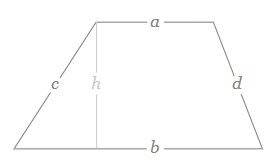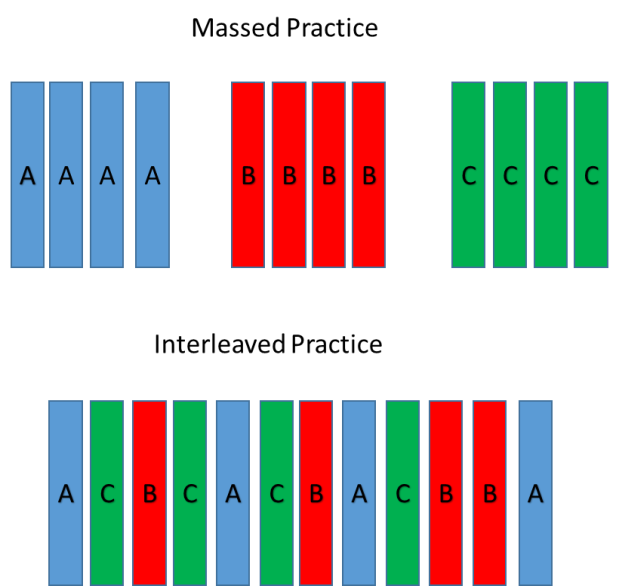Paul A. Kirschner & Mirjam Neelen

Last year, we wrote a blog on spaced learning and right before summer, we published one on retrieval practice. Both strategies are proven to be very effective for learning. There’s a third one that falls into the ‘effective learning strategy’ category –it’s evidence-informed – and that’s interleaving. And, no surprise probably, that’s what this blog is about. 😊
Two scenarios to paint the picture; one in an educational context, one in a workplace context.
 Education – You, as the teacher, have taught a lesson or given your students a piece of text that they need to learn. Hopefully, they’ve learned the content of the lesson or the text and now they’re ready for the next step: practice. What we usually see is what we call ‘crammed practice’ or ‘massed practice’, meaning that students practice something repeatedly until they know it or until get the hang of it (e.g., are able to do it). Although this type of practice is common, it unfortunately isn’t the best way to practice. Research clearly shows that there’s a better way to help students practice, namely through interleaving. In other words, through varying the types of exercises (Rohrer & Taylor, 206; Taylor & Rohrer, 2010). This has also been called ‘variability of practice’ (Van Merriënboer & Kirschner, 2018).
Education – You, as the teacher, have taught a lesson or given your students a piece of text that they need to learn. Hopefully, they’ve learned the content of the lesson or the text and now they’re ready for the next step: practice. What we usually see is what we call ‘crammed practice’ or ‘massed practice’, meaning that students practice something repeatedly until they know it or until get the hang of it (e.g., are able to do it). Although this type of practice is common, it unfortunately isn’t the best way to practice. Research clearly shows that there’s a better way to help students practice, namely through interleaving. In other words, through varying the types of exercises (Rohrer & Taylor, 206; Taylor & Rohrer, 2010). This has also been called ‘variability of practice’ (Van Merriënboer & Kirschner, 2018).
 Workplace – A worker follows a certain learning program, sometimes with ‘pre work’ (e.g., watching videos, reading articles to familiarise him or herself with some concepts and terms before diving deeper). The training can be virtual or in-person and usually includes some stories to explain concepts and give examples (e.g., about clients or other relevant aspects) and practice activities. After the training there’s often… nothing. At least, we’ve hardly ever seen examples where workers had the opportunity to continue practicing in a safe environment after the formal training experience. Similar to the education context, interleaving can play a role to improve learning (and in the workplace, this means, applying what is learned on the job to improve job performance).
Workplace – A worker follows a certain learning program, sometimes with ‘pre work’ (e.g., watching videos, reading articles to familiarise him or herself with some concepts and terms before diving deeper). The training can be virtual or in-person and usually includes some stories to explain concepts and give examples (e.g., about clients or other relevant aspects) and practice activities. After the training there’s often… nothing. At least, we’ve hardly ever seen examples where workers had the opportunity to continue practicing in a safe environment after the formal training experience. Similar to the education context, interleaving can play a role to improve learning (and in the workplace, this means, applying what is learned on the job to improve job performance).
Before you think: “There they go again; more work for me!” we need to make clear that interleaving is relatively simple to apply and doesn’t require any major adaptations in how a teacher teaches or how a (virtual or in-person) facilitator facilitates. Also, any individual, be it a student or a worker, can easily apply interleaving, on their own or with others, with or without computers. It requires some thinking about the design of the activities, but all told, interleaving costs NOTHING extra!
What is interleaving?
With interleaving, the teacher or learning designer makes sure that a sequence of exercises or problems that (s)he gives the learner can’t be solved using one and the same strategy, rule, concept, or whatever. So, for example, instead of offering a ‘block’ of exercises around calculating the surface area of a triangle (A = (hb + b) / 2) until students are able to apply it, then doing the same for a trapezoid (A = (a + b +h)/2), a rhombus (A =(p + q)/2), etcetera, with interleaving, you’ll take a very different approach!
 |
 |
 |
When using the interleaving strategy for learning how to calculate the surface area of any object, you would, for example, start with an exercise on calculating a triangle, followed by a trapezoid, followed by another triangle, followed by a rhombus, and so forth. Similarly, when learning how to conjugate verbs in Dutch, you’d mix exercises with regular verbs, irregular verbs, weak and strong verbs, etcetera. In the workplace context, an example could be in the context of teaching workers about the process of robotic process automation (how to automate currently human-driven processes). After explaining the process and giving some examples, sharing some exceptions and common mistakes, provide the workers with scenarios that each have slightly different variables so that they need to decide which concepts and/or strategies are applicable and how to apply them in the context at hand.
Note: Just to make it crystal clear, with the risk of stating the obvious: With interleaving, the ‘practice topics’ are related (like, interleaving isn’t practicing the area formula with a triangle, followed by Dutch regular verbs, then Dutch weak verbs, next the area formula with a circle, and so forth!).
More ‘abstractly’ put: You don’t choose for a block of similar exercises – AAAABBBBCCCC – but rather for a sequence of alternating exercises – ABACBCAABCBC. Another way of representing this approach is illustrated in the image.

In doing so, you achieve several (good!) things. For starters, you add a layer where learners need to decide which strategy they need to choose to complete the exercise (e.g., to solve the problem). This means, they need to familiarise themselves with the task at hand (e.g., read it) and then think about it. They need to think about what to do instead of you telling them what to do! Second, you help learners figure out what distinguishing elements there are on which they need to base their choice of approach. Next, interleaving leads to fewer errors in the long run. In other words, there’s less risk that they’ll pick the wrong approach to solve a problem. Finally, interleaving leads to better transfer of knowledge and skills, or, better application of what you know and can do in novel situations.
How to Do It?
- Just deliver your lesson or learning program. No changes needed! Piece of cake!
- Within the exercises and/or practice activities that you design, alternate between strategies, approaches, rules, etcetera, that are required to complete the task.
- Don’t dwell on one single topic.
- Change the sequence; mix it up! Don’t fall into the habit of using an ABCABCABC routine.
- When discussing the various activities and exercises, make sure to connect the dots between the several ideas. Explain why a certain approach works within one context but doesn’t in another. In other words, feedback is extremely important (also see our blog on feedback).
One thing to pay close attention to is this: Although it’s definitely good to alternate between activities, you need to make sure to limit the number of strategies. So, don’t change too often between too many different topics. This might confuse the learner, plus spending too little time on one strategy also isn’t fruitful. After all, you want people to be able to understand what they’re doing and why they need to do it that way. Some concepts might even need to be memorised (e.g., multiplication tables or vocabulary).
To conclude: Interleaving might feel ‘more difficult’ for the learners and it even can take longer to get to the desired level of competency. But…the reward is big! Interleaving helps to learn better and deeper!
References
Rohrer, D., & Taylor, K. (2006). The effects of overlearning and distributed practice on the retention of mathematics knowledge. Applied Cognitive Psychology, 20, 1209–1224. Available from: https://pdfs.semanticscholar.org/5720/cbea1d4dc2d3da3b2ee176ee9d3ef377f294.pdf
Taylor, K., & Rohrer, D. (2010). The effect of interleaving practice. Applied Cognitive Psychology, 24, 837–848. Can be requested here: https://www.researchgate.net/publication/227530785_The_Effects_of_Interleaved_Practice
Van Merriënboer, J. J. G., & Kirschner, P. A. (2018). Ten steps to complex learning (3rd edition). New York, NY: Routledge.

Reblogged this on kadir kozan.
LikeLike
Mirjaam, I loved what i read here.But when I am trying to see how I can apply this to our technical skills design, I am struggling to understand your point. Where can I reach you to discuss this?
LikeLike
Hi, there. I’m not sure what you mean with ‘technical skills’ but what it comes down to is that you need to analyze a) what the authentic tasks are that the learners need to be able to complete and b) what the part tasks (tasks that need additional practice to train a selected routine aspect of a complex skill) are. Focus on the part tasks for now and mix them up sequence wise so that people practice a wide variety of tasks instead of practicing the same one repetitively.
LikeLike